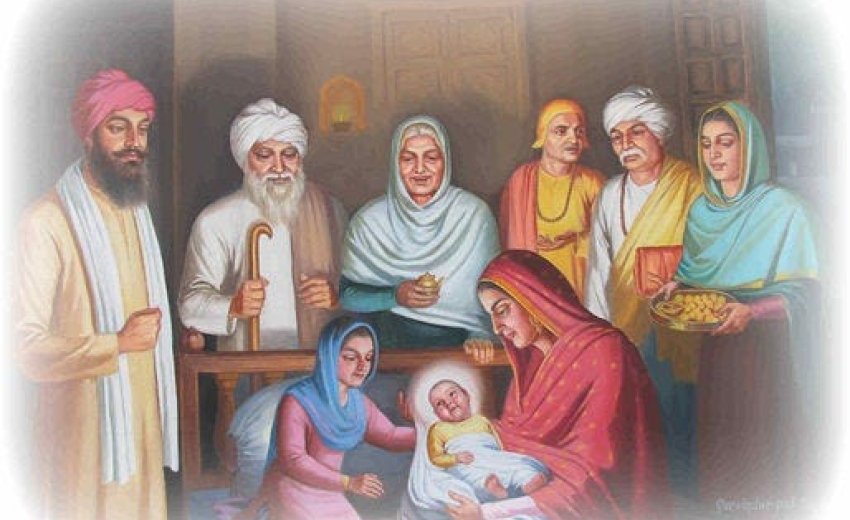Guru Nanak's life story has been pieced together by scholars from various sources, primarily from Janamsakhi literature, as there is no definitive biography
Sikhism is a religion that teaches equality, compassion, and service to others. Guru Nanak, the founder of Sikhism, played a significant role in shaping its principles. There's been ongoing debate regarding Guru Nanak's date of birth. Traditionally, it's believed he was born in Katik (October-November) on the full moon night in 1469. Consequently, Sikhs worldwide celebrate his birthday during this time. However, modern scholars disagree with this date. Their research suggests that Guru Nanak was actually born in Baisakh (April) of 1469.
How did the celebrations start in Katik when he was born in Baisakh ?
Guru Nanak's life story has been pieced together by scholars from various sources, primarily from Janamsakhi literature, as there is no definitive biography. According to the Bala Janamsakhi, Guru Nanak was born in Katik. Many Sikh preachers believe this account, attributing it to Bhai Bala, who, along with Bhai Mardana, accompanied Guru Nanak on his travels. It is said that Bhai Bala wrote a janamsakhi under the guidance of Guru Angad.
Bala Janamsakhi
The Bala Janamsakhi was written by a person named Gorakh Das back in 1658. Nowadays, it's kept in the private collection of Piare Lal Kapur in Delhi. This book has been quite popular among Sikhs for a long time, and it still is today. One big reason for its popularity is the stories of miracles associated with Guru Nanak, which many people, especially those from rural areas, find fascinating and believe in. In various paintings and old pictures, Bala and Mardana are depicted as companions of Guru Nanak during his travels, leading many to think that Katik is Guru Nanak's birth date, as stated in the Bala Janamsakhi.
However, the Bala Janamsakhi has its flaws. It seems to show more respect towards Baba Hindal, the father of the sect's founder, while not giving Guru Nanak the same level of respect. Even Bhai Santokh Singh, who is one of the few notable scholars supporting the Bala Janamsakhi, acknowledges the influence and alteration by the Hindali sect. Scholars also point out that the language used in the Bala tradition wasn't spoken during Guru Nanak's time. Hew McLeod notes, "A critical analysis of the linguistic characteristics of Bala and Puratan Janam Sakhis reveals that the language of the later is older than that of the Bala Janamsakhi , the language of the puratan is akin to that of Guru Granth”
Khushwant Singh, the renowned author, points out in his analysis that the language used in the Bala janamsakhi wasn't spoken during Guru Nanak or Guru Angad's time, but rather developed around a hundred years later. Some phrases like "Wahe Guru ji ki Fateh" were used during Guru Gobind Singh ji's era. Additionally, certain hymns attributed to Guru Nanak in the Bala janamsakhi actually belong to the second and fifth gurus. Although it's claimed that Guru Angad commissioned Bala Sandhu to write the janamsakhi, there's no historical evidence that they ever met or knew each other. It's possible that Bala Sandhu was a follower of Guru Nanak but not his travel companion.
Interestingly, Bhai Gurdas, who was very close to Baba Buddha, a contemporary of Guru Nanak, doesn't mention Bala's name, even though he lists other devotees of the Guru in his writings. While there's a hymn of Mardana in the Adi Granth, there's no mention of Bala or anything attributed to him.
Puratan Janamsakhi
Bala's name isn't mentioned in the Vilayatvali janamsakhi or the Colebrook janamsakhi, which are kept in the old India Office Library in London. The Vilayatvali janamsakhi manuscript was taken to England in 1815 by Henry Thomas Colebrook, a Sanskrit scholar, and placed in the East India Company's library. Dr. Earnest Trumpp, despite his critical views on the holy Guru Granth Sahib, was the first scholar to discover and examine it in 1872 upon his return to Europe. However, he didn't find any reference to Bala in the Janamsakhi. Trumpp doubted the authenticity of the Bala janamsakhi, which states Katik as the date of Guru Nanak's birth. Some copies of the Colebrook janamsakhi were brought to Punjab in 1883 by Lt. Governor Charles Aitchison after a petition from Sikhs in Amritsar.
Prof. Gurmukh Singh, a prominent leader of the Lahore Singh Sabha, discovered another janamsakhi at Hafizabad, now in District Gujranwala, Pakistan. Gurmukh Singh lent this discovery to Macauliffe, who privately published the text in 1885 after dividing its unbroken lines into separate words. This version is referred to as the Hafizabad Janam Sakhi or the Macauliffe vali Janam Sakhi. Its contents closely resemble those of the Colebrooke janamsakhi. These two manuscripts are considered significant in the Puratan tradition.
Sikh historian Karam Singh discovered five more ancient manuscripts, one of which was dated back to 1733 A.D. All these manuscripts agreed with the accounts found in the earlier two janam-sakhis. With this wealth of evidence, Karam Singh published his research in 1913 under the title "Katik ke Baisakh". He revealed the unreliability of the Bala Janamsakhis, disproved Bala's association with Guru Nanak, and presented a compelling argument supporting Baisakh as the correct birth date of Guru Nanak.
The puratan janamsakhi, as it predates the Bala Janamsakhi, is referred to as the "old" janamsakhi. However, there is some debate surrounding its origin. While Kirpal Singh argues it was written in 1634, Kahn Singh Nabha, along with Khushwant Singh and Gopal Singh, assert that it dates back to the late 16th century (1588), attributed to Sewa Das. McLeod refrains from providing an exact date but suggests it was penned during the time of Guru Arjan, stating,
"Its language and grammatical constructions show that this janam Sakhi must have been written around the time of the compilation of Adi Guru Granth Sahib." This was also the time when Meharban Janamsakhi and Bhai Gurdas's first Var were written.
Meharban Janamsakhi
Manohar Das Meharban, the son of Prithi Chand, who was the eldest brother of Guru Arjan Dev, had a deep spiritual inclination. He shared a close bond with the fifth Guru and received his education and knowledge about Sikh tradition directly from Guru Arjan Dev himself. Meharban also authored a janamsakhi of Guru Nanak, which some scholars suggest was written even before Bhai Gurdas composed his first Var. The contents of his janamsakhi closely resemble those of the Puratan janamsakhi. According to McLeod, the account of Guru Nanak's death in the Bala janamsakhi is believed to be influenced by Meharban's tradition. Additionally, Meharban identifies April as Guru Nanak's birth date.
Other evidence :
In many classical works like Gyan Ratnavali (1712) by Bhai Mani Singh and Mehma Parkash (1776) by Sarup Das Bhalla, April is mentioned as the birth month of Guru Nanak. Bhai Santokh Singh, in his significant work Nanak Prakash (1823), mentions Katik Pooramashi as the date, but he also calculates Guru Nanak's total age as 70 years, 5 months, and 7 days. Karam Singh worked backward from Guru Nanak's death date, concluding that he must have been born in mid-April.
One of the most influential documents is a merging of the Colebrook and Hafizabad manuscripts, compiled by Bhai Vir Singh and published as Puratan Janam Sakhi in Amritsar in 1926. Nowadays, prominent historians such as M.A. Macauliffe, Hew McLeod, Kahn Singh Nabha, Indubhushan Banerji, Khushwant Singh, Kirpal Singh, Ganda Singh, Harbans Singh, H.R. Gupta, and others find the account in Puratan Janamsakhi more reliable. They accept April as Guru Nanak's birth month as mentioned there.
In conclusion, even though the tradition strongly favors Katik (November) as the birth month, the historical evidence points to April 15, 1469 C.E. for Guru Nanak's birth.
*Based on an article by Jagpal S Tiwana, published in Maritime Sikh Society on 9th May 2013

